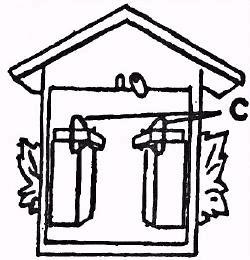Cuckoo!
 I’ve been a little obsessed with cuckoo clocks for the past few weeks, and here are a few cuckoo-related oddments.
I’ve been a little obsessed with cuckoo clocks for the past few weeks, and here are a few cuckoo-related oddments.
A friend of mine gave me an unwanted cuckoo clock, and I repaired it and hung it on a wall at home. Every time the cuckoo chime goes off, it makes me giggle. Sadly, most of the other members of my household find the noise annoying; so the clock will stay on “mute” for much of the day. I asked my co-workers if they would terribly mind if I installed the cuckoo clock in the office, and was greeted with dead silence.
So… no cuckoo clock in the office, I guess.
Incidentally, an excellent way to become my friend is to give me some piece of unwanted 19th century technology. Cuckoo clocks, accordions, Jacquard looms, fully functional steam engines — these are all excellent choices. But I digress…
The traditional call of the cuckooo clock is a two-note melody: “cuc-koo! cuc-koo!” The rendition commonly heard in these clocks is a descending major third (such as the pitches E and C). The call of the cuckoo was notated as a descending minor third (F and D) in 1650 by Athanasius Kircher, in his wonderful book Musurgia Universalis. Shown above is an excerpt from a famous illustration in that book which notates the calls of various European birds, including the nightengale and the cuckoo. Perhaps the calls started as minor thirds, but most of the modern clocks I’ve heard use a major third.
Artisans started making cuckoo clocks in the black forest region of Germany about a hundred years after Kircher’s book. Most of the kitschy clocks being sold today are based on 19th and early 20th century designs. Whether those first clocks used minor thirds, or major thirds, I don’t know. The cynic in me likes to think they used minor thirds, but then the marketing guys made ’em fix it: “We need happier sounding clocks!”
I don’t particularly like the cases of most cuckoo clocks (they range from “not too tacky” to “quick! put it in the attic with the waffle iron!”), but I love the silly noise and the simplicity of the mechanism that produces it.
 The cuckoo’s call is produced by two whistles, each operated by a small bellows at the top. The clock movement pumps the bellows to make the call, at the same time striking a gong — mine is made of a coil of wire — mounted on the back of the clock. The tail of the cuckoo bird is attached to one of the bellows-tops, so that the bird bobs down on the first note and back up on the second note.
The cuckoo’s call is produced by two whistles, each operated by a small bellows at the top. The clock movement pumps the bellows to make the call, at the same time striking a gong — mine is made of a coil of wire — mounted on the back of the clock. The tail of the cuckoo bird is attached to one of the bellows-tops, so that the bird bobs down on the first note and back up on the second note.
Here’s Ralph Brendler’s page which describes how he make a home made cuckoo clock, using readily available parts (movement, bellows, etc) from a clock supplier. This page also has a pretty detailed description of how the chiming mechanism works.
If I were to make my own cuckoo clock, I think I’d deviate a bit more from the classic designs. I think it would be cool to make a nautical themed cuckoo clock, with carvings of various sea critters: octopusses and star fish. When the door opens up, out pops a shark! The two whistles are tuned to an ascending minor 2nd, so that instead of hearing “cuc-koo!” you hear the two notes from the theme to “Jaws,” by John Williams. Perhaps there are some other good two-note themes that would make for good clocks.
I’ve also been thinking about making a programming environment for kids called “Cuckoo”. The environment would make it easy to assemble automatons and clockworks with gears — you’d snap the gears together and they would automatically mesh and “work” properly. One of the built-in projects would be a working virtual cuckoo clock. I must admit, the name, “cuckoo,” came before the idea. But sometimes, a cool idea must start with a cool name.
Sadly, it is likely I won’t have much time to work on either of these cool projects this year, since I’ve been enormously busy working on things that actually generate money. But cuckoo-clock design sounds like an awfully nice gig, doesn’t it?


April 5th, 2006 at 1:30 am
[…] There are also existing versions of a related device, the Arca Musarithmica or Arca Musurgica which contained tables for music only, and had a larger set of music tables than the Organum. This device was described in detail in book 8 of Kircher’s massive tome, Musurgia Universalis (1650), shown below, with the fold-out illustration of the Arca. I mentioned this book a couple of weeks ago, in connection with Cuckoo Clocks. […]